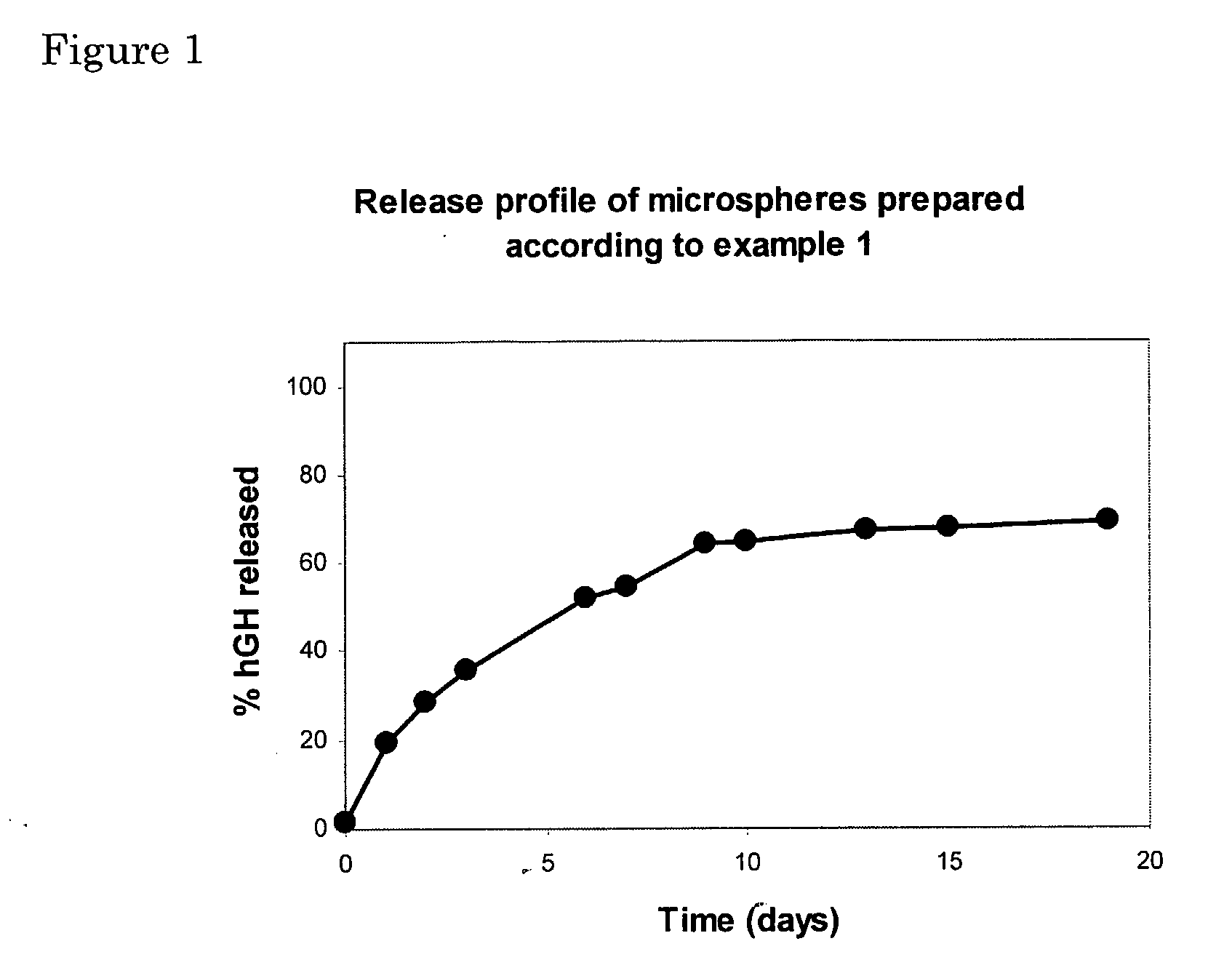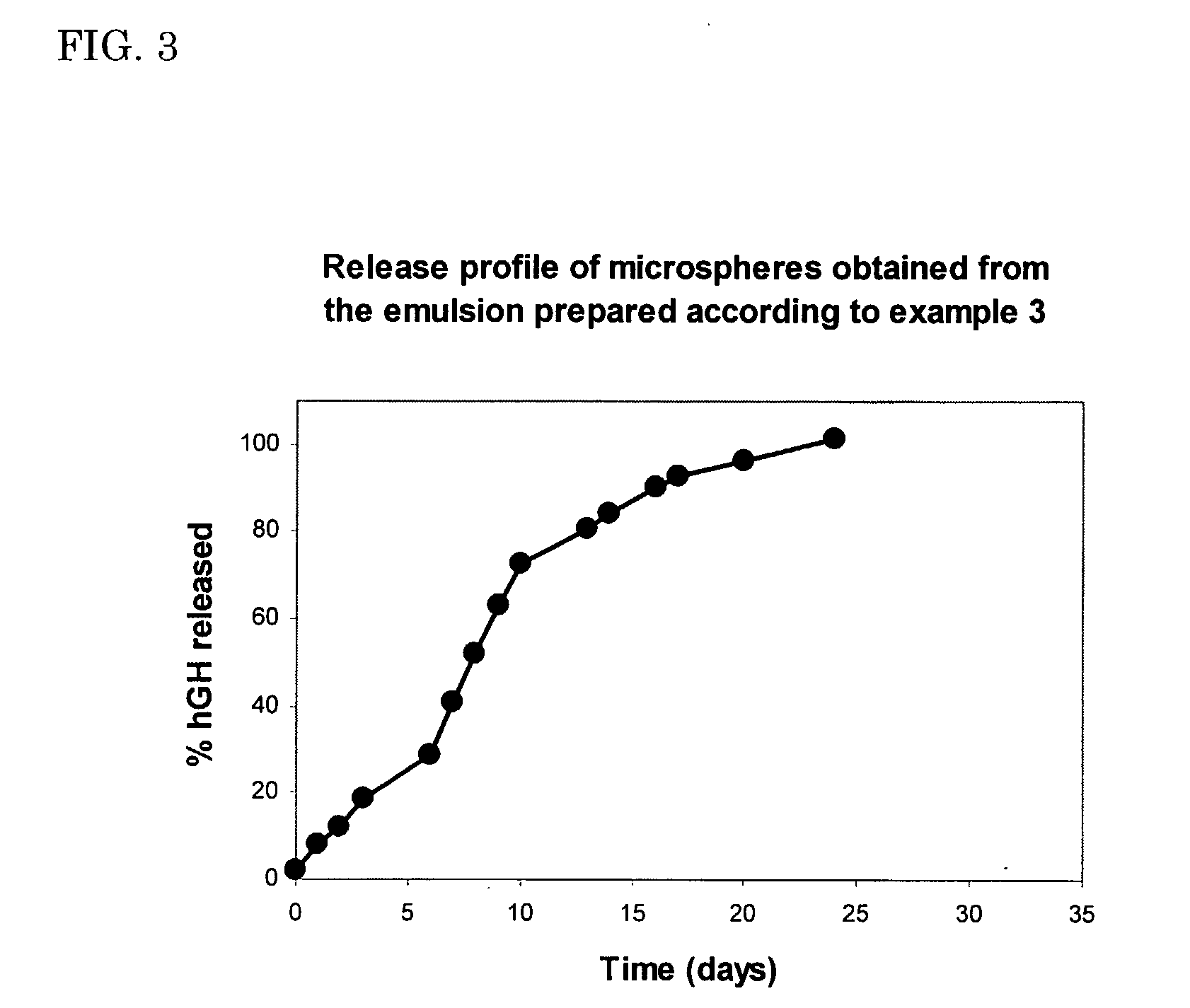Hydrogel Microspheres with Improved Release Profile
a technology of hydrogel microspheres and hydrogel microspheres, which is applied in the field of water-based methods, can solve the problems of requiring the use of organic solvents, organic solvents, and many bioactive proteins that are difficult to incorporate into the delivery system, and achieve the effect of overcoming or at least reducing or minimizing limitations and disadvantages
- Summary
- Abstract
- Description
- Claims
- Application Information
AI Technical Summary
Benefits of technology
Problems solved by technology
Method used
Image
Examples
example 1
(Comparative Example): Preparation of hGH-Loaded Microspheres with high content of insoluble aggregates
[0093]Microspheres were prepared by a water-in-water emulsion technique. In detail, an aqueous solution of 0.2 g of 20% (w / w) dextran hydroxyethylmethacrylate (dexHEMA, DS=16, MWdex˜40,000), containing 6 mg of dissolved human growth hormone (hGH), was added to 4.8 g of a 20% (w / w) PEG solution (MWPEG˜10,000). The components were vigorously mixed for 1 minute by vortexing. The resulting emulsion was allowed to stabilise for 10 minutes. Subsequently, 180 μl of a KPS solution (50 mg / ml) and 100 μl of a 20% (v / v) TEMED solution (pH neutralized with 4M HCl) were added to start the polymerisation of the HEMA groups. The mixture was incubated for 30 minutes at room temperature without stirring, yielding crosslinked, solidified hydrogel microspheres. The microspheres were washed three times with PBS.
[0094]The spheres were tested in vitro for their drug release properties. The release exper...
example 2
Preparation of a W / W-Emulsion Using Lyophilised hGh
[0095]3 mg of solid, freeze dried hGH were mixed with 30 mg of a 50% (w / w) aqueous solution of dexHEMA (DS=16, MWdex˜40,000). After thoroughly mixing, 2.9 g of a 27% (w / w) PEG solution (MWPEG˜10,000) was added. This was vigorously mixed for 1 minute by vortexing. The resulting emulsion was allowed to stabilise for 10 minutes. The absence of insoluble hGH aggregates was confirmed by size exclusion chromatography.
example 3
Preparation of a w / w-Emulsion Using a Freeze Dried Mixture of hGh and Dextran Hydroxyethylmethacrylate (dexHEMA)
[0096]A solution of 2.5 mg of hGH and 30 mg of dex-HEMA (DS=16, MWdex˜40,000) was freeze dried in a vial. The freeze dried material was homogeneously mixed with 60 mg of water. Subsequently, 4.9 g of a 27% (w / w) aqueous PEG solution (MWPEG˜10,000) were added. The blend was vigorously mixed for 1 minute by vortexing. The resulting emulsion was allowed to stabilise for 10 minutes. The absence of insoluble hGH aggregates was confirmed by size exclusion chromatography.
PUM
| Property | Measurement | Unit |
|---|---|---|
| Diameter | aaaaa | aaaaa |
| Diameter | aaaaa | aaaaa |
| Diameter | aaaaa | aaaaa |
Abstract
Description
Claims
Application Information
 Login to View More
Login to View More - R&D
- Intellectual Property
- Life Sciences
- Materials
- Tech Scout
- Unparalleled Data Quality
- Higher Quality Content
- 60% Fewer Hallucinations
Browse by: Latest US Patents, China's latest patents, Technical Efficacy Thesaurus, Application Domain, Technology Topic, Popular Technical Reports.
© 2025 PatSnap. All rights reserved.Legal|Privacy policy|Modern Slavery Act Transparency Statement|Sitemap|About US| Contact US: help@patsnap.com



